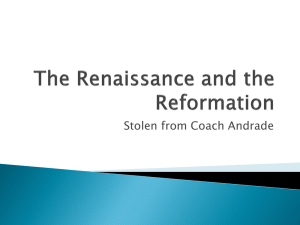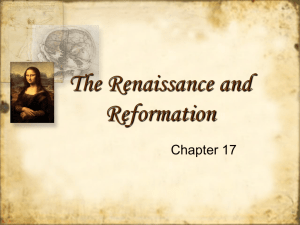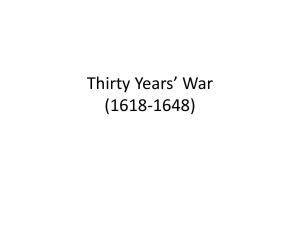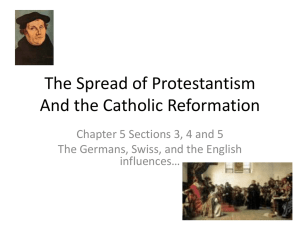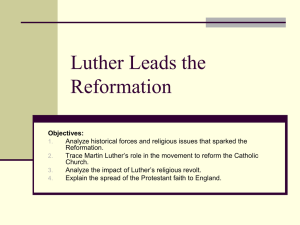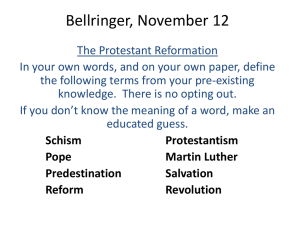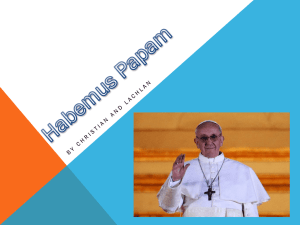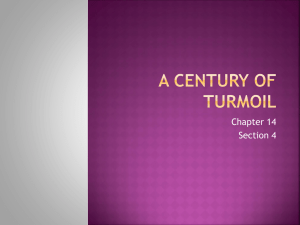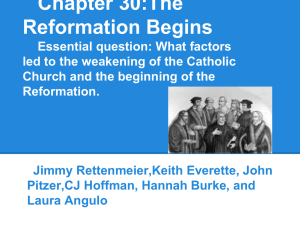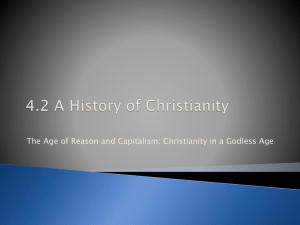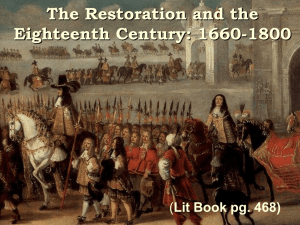Reformation PPT - Darien Public Schools
advertisement
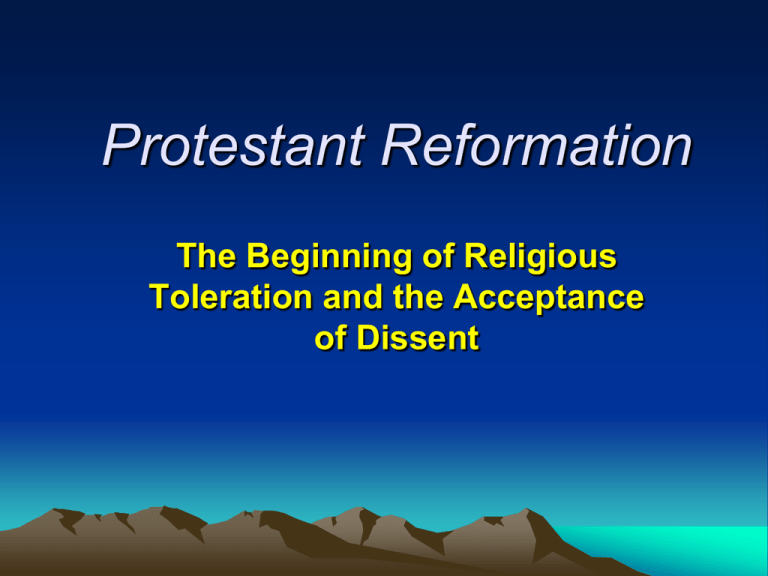
Protestant Reformation The Beginning of Religious Toleration and the Acceptance of Dissent Holy Eucharist – or Communion Communion Bread and Wine Based on the Last Supper Roman Catholics believe in Transubstantiation through the blessing, the substance of the bread and wine are exchanged for the body and blood of Jesus; Most Protestant Religions believe that the Bread and Wine are merely Symbolic and all people should drink What are the Precipitating Factors of the Reformation? • New ideas of the Renaissance. • New technology of the printing press. • Worldly concerns of the Renaissance popes. • Low standards of many local priests – uneducated, had wives, and unable to provide good spiritual guidance to people. • The zeal of indulgence sellers. John of Wycliffe in England Late 1300s First person to produce hand-written copies of the Bible in the English language.... John Wycliffe Claimed • Eucharist was merely symbolic • Pope was not the final authority • All people can drink from the communion cup Jan Huss in the HRE • 1390 – Wycliffe's writings reach eastern Europe • 1398 – Huss teaches heretic ideas in Czechoslovakia. 1410 - Huss and his followers excommunicated by Pope John XXIII • 1415 - Jan Huss burned at the stake for heresy. Gutenberg- Printing Press The invention that changed the world • 1450s - Created in Mainz, Germany An Original Guttenberg Bible sold for $5,400,000.00!!!! You may want to check your attic for any copies!!! Push Back Against material Excesses • Savonarola – Italian friar 1490s – Provokes repentance of Renaissance excesses of worldly pleasure. – 1497 – Florence – urges citizens to throw their fancy clothes, wigs, paintings into fire – Florentines turn against him Indulgences • Grants by the Church • Reduced time in Purgatory, said Tetzel Initially offered to Crusaders Eventually offered to the general public in exchange for a $$$$ contribution Purgatory Prior to ascending to heaven, a person must spend time here Pope Leo X and Tetzel Pope Leo, like Julius II wanted to beautify Rome Johann Tetzel- Sold Indulgences Pope Julius II’s tomb, by Michelangelo - temporarily abandoned for lack of funds Johann Tetzel: Dominican Friar • Commissioned by the Pope for a new cathedral in Rome – Prices for Letters of Indulgence • Robbing a church and pergury - 9 Ducats • Murder - 8 Ducats Luther’s 95 Theses Posted on the Doors of Wittenburg Cathedral Objected to the Sale of Indulgences He burns a Papal bull telling him to recant his words or be excommunicated… Many Germans cheer!............. This is the BEGINNING OF PROTESTANT REFORMATION THE Some of the Theses… 20. Therefore the Pope, in speaking of the perfect remission of all punishments, does not mean that all penalties in general be forgiven, but only those imposed by himself. 21. Therefore, those preachers of indulgences err who say that, by the Pope's indulgence, a man may be exempt from all punishments, and be saved. Some of the Theses… 32. On the way to eternal damnation are they and their teachers, who believe that they are sure of their salvation through indulgences. 79. He who says that the cross with the Pope's arm, solemnly set on high, has as much power as the Cross of Christ, blasphemes God. 80. Those bishops, curates, and theologians, who allow such speeches to be uttered among the people, will have one day to answer for it. Luther at the Diet of Wormsdefending himself- he’s Condemned Excommunicated and his books are ordered to be burned! Reformation Propaganda Luther’s 3 Main Tenets 1. Salvation is by faith alone. – Good Works do not lead one to heaven, only Faith in God 2. The Bible is the only authority for Christians. – All teachings should be based on the word of God and nothing else. 3. All people can have a Direct Relationship w/God. – Priests as intermediaries are unnecessary Luther Returns from Hiding • Prince Frederick of Saxony had hid him • What does he see in Wittenburg? – Ministers in ordinary clothes – German language – Marriage of ministers • Peasant Revolt 1524…to end serfdom. – How does Luther respond? – Princes armies massacre… Christian Humanists Thomas More and Desiderius Erasmus – Sought reform, not revolution… – Education and knowledge – Bible was important, but most individuals cannot read it correctly… – Influential Writings – More wrote Utopia – Erasmus (Holland!) In Praise of Folly The 6 Wives of Henry VIII • Initially opposed to the Reformation – Defender of the Faith • But sonless – – – – 1st Wife Catherine bore a girl She is Charles V’s aunt Charles V is Protector of the Pope Pope wouldn’t grant him a divorce Parliament passes Act of Supremacy • Church of England • Anne Boleyn Henry has 4 more wives Hans Holbein • But few children • Edward VI, Mary I, and Elizabeth I Executed Thomas More, a Christian Humanist In groups review homework: “Henry VIII: Search for an Heir” • In groups, answer the following: – Look up any words you don’t know meaning of 1.Why did Henry VII pledge Prince Henry’s hand in marriage to Catherine? 2.What motives help explain Henry VIII’s split with Rome? 3.How did Henry make secure the future reign of his son? Catherine of Aragon • Charles V’s aunt • Roman Catholic • Previously married to – Henry VIII’s brother, Arthur – Pope Leo said OK to remarriage • Didn’t want a divorce from Henry – Pope didn’t approve divorce – Divorced, raised her daughter, Mary The Reformation in England Soapstones Anne Boleyn and Henry VIII Primary Source Doc Speaker – who is it? Occasion – when and where was this written or spoken? Audience - who is the document addressed to? Prior Knowledge - what outside knowledge is helpful to understand what this is about? Subject - what is it about? Tone - what is the tone or attitude of the piece? (i.e. harsh, strenuous, moderate, mild, unfair, etc) Significance – so? What does this document tell us about the period/the event/the people? Anne Boleyn • Mother of future Queen Elizabeth – Henry VIII’s 2nd Wife – Accused of adultery – Executed by Henry – Daughter raised Protestant The Reformation in England Family Tree- Henry VIII , Catherine of Aragon and descendants Isabella and Ferdinand (Spain) (Catholic) Philip I Joana The Handsome Catherine of Aragon (Catholic) Henry VII (Catholic) Arthur… dies (Catholic) Henry VIII Catholic then Anglican 6 Wives Below (Hapsburg) Charles V (Catholic) King of Spain, Holy Roman Emperor, (Hapsburg) Philip II King of Spain 1. Catherine of Aragon (Catholic) (divorced) Mary (Catholic) 15531558 2. Anne Boleyn 3. Jane Seymour (Anglican) beheaded Dies (Anglican) Elizabeth Edward VI (Anglican) (Anglican) 1558-1603 1547-1553 Refuses to marry Phillip II 4. Anne of Clevesdissolved 5. Catherine HowardBeheaded 6. Katherine Parr- Dies after Henry does Charles V’s H.R. Empire Women of Influence: 1500s • Margaret More – Scholar, Thomas’ daughter • Catherine Parr • Queen Elizabeth • Marguerite of Navarre – Protestant sister of French king Francis – She sought to protect Protestants from her brother John Calvin – Calvinism • Predestination … God knows all Elect – Those, by God’s grace, who will go to heaven • The • Church dominates the State = Theocracy Escapes Francis’ persecutions Experiments in Geneva • A Christian utopia… • A theocracy • Crime drops, cooperation increases • No card playing or dancing • Keep the Sabbath John Knox - Scotland & the Presbyterian Religion • Follower of Calvin • Elders or presbyters • Calvinist nobles overthrew Catholic Mary of Scots – infant son James is put on the Throne Mary Queen of Scots Flees Presbyterian Uprising Fought against John Knox (Presbyterian) Roman Catholic Executed by Elizabeth Catholic (or Counter) Reformation Jesuits – Society of Jesus • Founded by Ignatius Loyola 1522 – Teachers of the Church - focus on education and trained priests – Convert Non-Christians especially in the New World – Stop Protestantism !!!!! Do you know any Jesuit Schools? Jesuit Colleges Pope Paul III • Investigate: simony, marriage, indulgences • Council of Trent: – Conference of Catholics • Pope Paul IV – Index of Forbidden Books – Book burnings Council of Trent 1545 Responds to Protestants 1. Pope is the final authority 2. Good WORKS and FAITH are the way to salvation 3. The Bible AND Church traditions are equally important 4. Indulgences, relics and pilgrimages are all valid expressions of faith But don’t sell false promises Fight! Charles v. Schmalkaldic League • Emperor Charles whips but cannot win • Catholic Princes will not help Peace of Augsburg – Princes decide Catholic or Lutheran: the religion of their realm • Don’t like it….MOVE!!! – NO Calvinism! Emperor Charles V Largest Empire in World History PROFILE • Holy Roman Emperor • King of Hapsburg Dynasty - Austria and German Territories • King of Spain • Orders Luther’s arrest • Fights Protestants •Peace of Augsburg • Tired and Unhappy After Peace of Augsburg,& he divided his lands and titles: • Son Philip II got Spain and Ntherlds • Brother, Ferdinand: HRE • Charles then enters a monastery!!! Christian Denominations Europe in 1580 • Catholic- Southern Europe: Spain, Portugal, Italy, France, Poland, southern parts of the Holy Roman Empire, Ireland • Lutheran- Scandinavia (Norway, Denmark and Sweden), Northern Germanic Holy Roman Empire • Calvinist and Presbyterian- Geneva, Switzerland; Scotland; Netherlands, scattered around Europe; • Anglican - England, parts of Ireland • Major Catholic Minorities in England • Major Protestant Minorities in France – “Huguenots” Effects of the Reformation: The Thirty Years War Emperor Charles V Largest Empire in World History PROFILE • Holy Roman Emperor • King of Hapsburg Dynasty - Austria and German Territories • King of Spain • Orders Luther’s arrest • Fights Protestants •Peace of Augsburg • Tired and Unhappy After Peace of Augsburg,& he divided his lands and titles: • Son Philip II got Spain and Ntherlds • Brother, Ferdinand: HRE • Charles then enters a monastery!!! Peace of Augsburg Collapsed in 1618: Thirty Years War 1618-1648 • HRE Ferdinand II made enemies in HRE • Catholic League v. Protestant Union – As a Hapsburg, other dynastic families hated him – Spark! Put down revolt in Lutheran Bohemia – German Lutheran peoples joined the fight The Triumph of Death by Peter Bruegel The Thirty Years War • A Fight for Religion and Political Power – Lutheran Sweden jumps in to fight • Push out Hapsburg armies • King Adolphus!! – Under Richelieu, France fights for Protestants! • Warfare: primarily in the German lands – 6.5 million die - 30% in areas of Germany The Treaty of Westphalia and its Long Range Outcomes • Peace of Westphalia 1648 – Princes of Germany can choose any Christian denomination – Power of the Nation-State increased and role of the Church diminished – Netherlands and Switzerland’s independence recognized – Germany was in ruins • Europe begins to have firmer borders, fewer fights about who owns what. • France emerges as most powerful in Europe in 1600s • Hapsburgs and HRE lose power Locate the outline map handout. Follow directions and label Netherlands, Scotland and Denmark, too 1648
